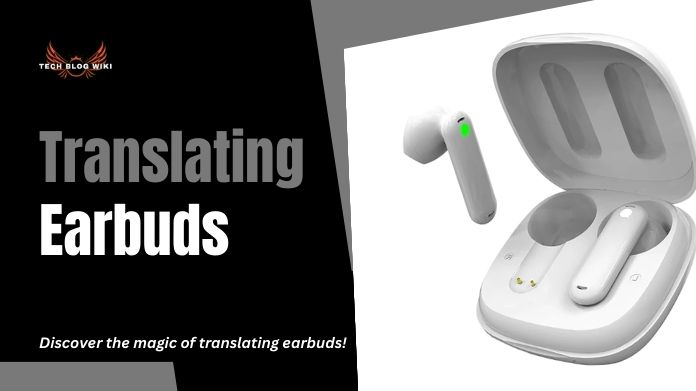In a world marked by diverse languages and cultures, the advent of translating earbuds has emerged as a transformative tool for seamless communication.
These innovative devices promise to break down language barriers, opening up a realm where individuals can engage in conversations without the constraints of linguistic differences.
This Techblogwiki exploration delves into translating earbuds, unraveling their functionalities, and how they facilitate cross-cultural communication.
From real-time translations to on-the-go language assistance, these earbuds redefine how we connect, fostering a global dialogue where understanding knows no linguistic bounds.
What is Translating Earbuds?

Translating earbuds are innovative audio devices equipped with advanced language translation technology to facilitate seamless communication between individuals who speak different languages.
These earbuds often utilize speech recognition, machine learning, and artificial intelligence algorithms to interpret spoken words in real-time and provide instant translations.
Key Features of Translating Earbuds
1. Real-Time Translation: These can rapidly convert spoken words from one language to another, enabling users to understand and respond to conversations in a language they may not be proficient in.
2. Two-Way Communication: Many translating earbuds support two-way translation, allowing both parties to understand each other, even if they speak different languages.
3. Language Variety: These devices often support multiple languages, making them versatile for diverse communication scenarios in international settings.
4. Compact and Wireless Design: These are typically compact, wireless, and effortlessly wearable, ensuring convenience and portability for users on the go.
5. Integration with Mobile Apps: Some translating earbuds integrate with mobile applications, offering additional features, customization options, and updates for enhanced user experience.
These earbuds play a pivotal role in breaking down language barriers, fostering cross-cultural interactions, and promoting global communication by making conversations more accessible and inclusive.
How Do Translating Earbuds Work?

Translating earbuds work through advanced technologies, including speech recognition, machine translation, and natural language processing.
Here’s a simplified overview of how these earbuds typically operate:
1. Speech Recognition: When a user speaks into the translating earbuds, the built-in microphone captures the spoken words and converts them into digital audio signals.
2. Language Processing: The digital audio signals are then processed using sophisticated algorithms for speech recognition. This involves breaking down the spoken words into individual components and identifying the phonetic elements.
3. Translation Algorithms: The recognized speech is then fed into machine translation algorithms. These algorithms analyze context, grammar, and vocabulary to translate the desired language accurately.
4. Text-to-Speech Conversion: The translated text is converted into speech using text-to-speech synthesis. This involves generating a synthetic voice that articulates the translated words.
5. Output to the User: The translated speech is then played through the earbuds’ speakers, allowing the user to hear the translated version of the spoken words. This entire process occurs in real-time, providing instant language translation during a conversation.
6. Two-Way Communication: For devices that support two-way communication, the process is replicated for the other party involved in the conversation, ensuring that both users can understand each other in their respective languages.
It’s important to note that the accuracy and effectiveness of translating earbuds can vary based on the sophistication of the algorithms, language pairs supported, and the quality of the device’s components.
As technology advances, it is increasingly capable of providing more accurate and natural translations in diverse language scenarios.
Advantages and Disadvantages of Translating Earbuds
Advantages
1. Cross-Cultural Communication: Translating earbuds facilitates communication between individuals who speak different languages, fostering cross-cultural interactions and understanding.
2. Real-Time Translation: These earbuds offer instant, real-time translation, allowing users to engage in conversations without delays or needing external translation services.
3. Versatility: Translating earbuds often support multiple languages, making them versatile tools for international travel, business meetings, or interactions in diverse language environments.
4. Portability and Convenience: The compact and wireless design of translating earbuds makes them highly portable and convenient for users on the go.
5. Inclusivity: They contribute to inclusivity by breaking down language barriers and enabling individuals with different linguistic backgrounds to participate in discussions and activities.
Disadvantages
1. Accuracy Challenges: Translation accuracy may vary, and nuances, idioms, or cultural context may only sometimes be accurately conveyed, leading to potential misunderstandings.
2. Limited Language Support: While many translating earbuds support significant languages, they may not cover less common or regional languages, limiting their effectiveness in specific contexts.
3. Dependence on Technology: Users may become reliant on translating earbuds, potentially hindering the development of language skills or an understanding of local cultures.
4. Cost: High-quality translating earbuds with advanced features can be relatively expensive, making them less available to some users.
5. Battery Life: The need for continuous earbuds may drain the battery quickly, requiring frequent recharging, which can be inconvenient in certain situations.
Frequently Asked Questions
Q: How Good Are Translating Earbuds at Translating Languages Instantly?
Ans: Translating earbuds can provide accurate instant translations, but their effectiveness depends on factors like the quality of technology and the languages involved. They’re great for general conversations but might need help with idioms or specific cultural expressions.
Q: Can Translating Earbuds Replace Learning a Language?
Ans: While it helps with communication, they’re not a substitute for learning a language thoroughly. They’re handy for quick translations, but traditional learning methods are essential for a deep understanding of a language and culture.
Q: Do Translating Earbuds Work Without the Internet?
Ans: Most translating earbuds need an internet connection for real-time translation. Some may have limited offline capabilities, but for the full range of features, it’s best to use them with an internet connection. Check your earbuds’ specifications for offline use details.
Conclusion
As we conclude our journey through the domain of translating earbuds, it’s evident that these technological marvels are not merely gadgets but bridges uniting diverse linguistic landscapes.
The power to comprehend and be understood, irrespective of language, lies encapsulated within these compact devices. It represents a triumph of innovation and a testament to the potential for global unity.
In a world where communication is key, these earbuds are unlocking doors to meaningful interactions, fostering connections that transcend linguistic challenges.
Embracing the future of communication, it stand as ambassadors of a borderless world where conversations flow effortlessly, binding us together in a tapestry of shared understanding.






